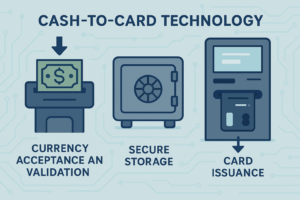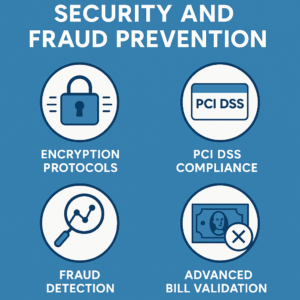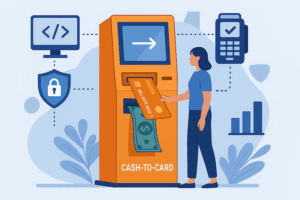Modern payment ecosystems increasingly demand solutions that balance operational efficiency with customer accessibility. Cash-to-card kiosks (also known as reverse ATMs) have emerged as strategic infrastructure that enables businesses to transition to cashless environments while continuing to serve customers who prefer or rely on cash. This guide examines the technical, operational, and strategic considerations business owners should evaluate to ensure successful implementation.
What is Cash-to-Card Technology?
 Core Architecture
Core Architecture
At their foundation, cash-to-card kiosks represent the integration of hardware and software designed to convert physical currency into digital payment credentials. The technology typically involves three critical components working in sequence:
- Currency acceptance and validation – High-accuracy bill acceptors verify currency authenticity using optical scanning, magnetic sensing, and counterfeit detection methods.
- Secure storage – Validated funds are placed into tamper-resistant storage with multiple layers of protection and audit trails to ensure both physical security and financial reconciliation.
- Card issuance – Prepaid cards, often branded for the venue or merchant, are encoded with equivalent value and activated instantly for use.
Touchscreen interfaces, intuitive prompts, and real-time confirmations help guide customers through the process with minimal friction.
Software and Payment Integration
The software layer is as important as the hardware, because it governs everything from transaction speed to compliance. These systems:
- Manage account creation, card activation, and balance tracking.
- Provide real-time communication to ensure funds are available immediately at point-of-sale terminals.
- Detect potential fraud by monitoring transaction patterns.
- Integrate with payment processors and POS systems to ensure compatibility and compliance with industry standards.
Analytics platforms are often embedded to give operators insight into usage patterns, transaction volumes, and system performance. This data supports both operational management and long-term planning.
How to Perform Deployment Planning and Site Assessment for Reverse ATMs and Cash to Card Kiosks
Location Strategy
Selecting where to place kiosks can determine the success of implementation. High-traffic, visible areas — near entrances, ticketing lines, or concession areas — maximize adoption. Placement should reduce bottlenecks and customer confusion, while remaining easily accessible to staff for monitoring and servicing (for more on optimal deployment locations, see our guide on the 8 uses for cash-to-card kiosks and specific implementation strategies for sports arenas and stadiums).
Infrastructure Requirements
Kiosks require reliable access to both electricity and network connectivity. Physical space should allow for comfortable customer interaction without obstructing traffic flow. Compliance with accessibility regulations such as ADA standards ensures that all customers can complete transactions independently.
Security Considerations
Deployment must also account for customer safety and operational risk. Clear sightlines, adequate lighting, and video surveillance integration all strengthen security. Placement decisions should balance convenience with protection against misuse or tampering. For a comprehensive overview of deployment best practices, see our complete guide to cash-to-card kiosk deployment.
Optimizing Transaction Flow and User Experience
The customer journey through a kiosk must be seamless. Intuitive interface design, combined with clear language and visual prompts, reduces confusion and shortens transaction times. Multi-language support is increasingly standard, reflecting the diverse populations that use these systems. Branding options, such as customized interfaces or kiosk wraps, allow businesses to reinforce their identity while still ensuring clarity. The most critical moment is card dispensing. Users must feel confident that the process is complete, with clear instructions to remove the card and immediate confirmation that funds are available. This reassurance directly impacts adoption and repeat use.
 Security and Fraud Prevention
Security and Fraud Prevention
Because kiosks handle both cash and digital payments, robust security is essential. Systems are typically designed with:
- Encryption protocols that secure customer data from the point of entry to activation.
- Compliance with PCI DSS to ensure proper handling of cardholder data.
- Fraud detection systems that flag unusual patterns for review.
- Advanced bill validation that identifies and rejects counterfeit or damaged currency.
These layers work together to protect both the business and the customer, building trust in the system.
Understanding Operational Management and Maintenance
Successful kiosk operations depend on consistent management practices. Routine responsibilities include:
- Cash collection – Balancing collection frequency with security and operational efficiency.
- Preventive maintenance – Scheduled servicing reduces downtime and prolongs equipment life.
- Inventory management – Monitoring prepaid card stock and ensuring timely restocking.
- Remote monitoring – Many systems allow operators to identify issues before they affect customers, such as low card supplies or connectivity disruptions.
Together, these practices maintain uptime, protect revenue, and preserve customer trust.
Financial Modeling and ROI
Understanding the key benefits of reverse ATMs helps frame the ROI discussion and business case. Evaluating the business case for cash-to-card kiosks requires balancing costs against both tangible and intangible returns.
Cost advantages come from reduced cash handling, lower risk of theft or loss, and labor savings. By moving cash transactions into automated systems, staff resources can be redeployed to revenue-generating tasks. Faster transaction processing also reduces lines and increases throughput during peak times.
Revenue opportunities may emerge through higher overall spending once customers transition to card-based payments, as well as through potential surcharges or convenience fees depending on the regulatory environment.
Break-even analysis should incorporate transaction volume, average load size, installation and service costs, and labor savings. Transparent fee structures — whether flat service agreements or revenue-sharing — are critical to accurately modeling return on investment.
 How to use Reverse ATMs for Marketing and Customer Engagement
How to use Reverse ATMs for Marketing and Customer Engagement
Kiosks can also extend beyond pure payment infrastructure. Many operators leverage them as marketing tools:
- Branded cards reinforce customer loyalty and create ongoing visibility outside the venue.
- On-screen promotions allow targeted advertising during the transaction process.
- Receipt-based offers can promote events, loyalty programs, or special discounts.
When strategically integrated, these features turn kiosks into dual-purpose assets that support both payment and marketing objectives.
Vendor Evaluation and Selection
While specific features vary, several criteria consistently define strong kiosk partners:
- Industry experience and a track record of successful deployments.
- Compliance certifications (e.g., ISO 9001:2015, PCI DSS) demonstrating adherence to standards.
- Support infrastructure, including technical assistance, service-level agreements, and maintenance capabilities.
- Pricing transparency, so decision-makers understand the total cost of ownership without hidden fees.
The right vendor should demonstrate both technical competence and an ability to align with the business’s long-term operational and strategic goals. For more guidance on evaluating vendors, see our article answering common questions about cash-to-card kiosks.
Conclusion
Cash-to-card kiosks are no longer experimental — they are becoming a standard bridge between cash-dependent customers and increasingly cashless environments. Their value lies in creating operational efficiency, reducing risks, and supporting better customer experiences, all while positioning businesses for future-ready payment ecosystems.
When implemented thoughtfully — with careful attention to technology, security, deployment strategy, and vendor partnerships — cash-to-card kiosks can deliver measurable ROI and become a cornerstone of modern payment infrastructure. Interested in learning more about where this technology is heading? Explore more with our guide to future trends in cashless payment technologies!
Cash to Card and Reverse ATM Implementation FAQ
How much does it typically cost to implement cash-to-card kiosks?
Implementation costs vary based on kiosk specifications, transaction volume, and service agreements. Most vendors offer either flat-rate service agreements or revenue-sharing models. Contact us for a customized quote based on your specific requirements.
How long does installation and setup typically take?
Standard installation usually takes 1-2 days per kiosk, including network setup, testing, and staff training. Larger deployments may require additional coordination time.
What happens if the kiosk runs out of cards or breaks down?
Modern systems include remote monitoring that alerts operators before supplies run low. Most service agreements include response time guarantees for technical issues, with backup procedures to minimize customer impact.
Do customers actually use these kiosks, or do they just ignore them?
Adoption rates vary by venue type and customer demographics, but proper placement and clear signage typically result in steady usage. Many operators see a substantial number of cash customers transitioning to kiosk use within the first few months.
Can we set our own fees or card loading limits?
Fee structures depend on your service agreement and local regulations. Card loading limits can usually be customized based on your average transaction sizes and risk tolerance.

 Core Architecture
Core Architecture Security and Fraud Prevention
Security and Fraud Prevention How to use Reverse ATMs for Marketing and Customer Engagement
How to use Reverse ATMs for Marketing and Customer Engagement